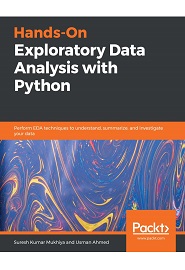
English | 2020 | ISBN: 978-1789537253 | 337 Pages | PDF, EPUB | 97 MB
Discover techniques to summarize the characteristics of your data using PyPlot, NumPy, SciPy, and Pandas
Exploratory Data Analysis (EDA) is an approach to data analysis that involves the application of diverse techniques to gain maximum insights into a dataset. This book is designed to help you gain practical knowledge of the main pillars of EDA, including data cleaning, data preparation, data exploration, and data visualization.
You’ll start by performing EDA using open source datasets and perform simple-to-advanced analyses to turn data into meaningful insights. You’ll then learn various descriptive statistical techniques to describe the basic characteristics of data. The book will also help you get to grips with performing EDA on time-series data. As you advance, you’ll learn how to implement EDA techniques for model development and evaluation and build predictive models to visualize results. By using Python for data analysis, you’ll work with real-world datasets, understand the data, summarize its characteristics, and visualize it for business intelligence.
By the end of this book, you’ll have developed the skills to carry out a preliminary investigation on any dataset, yield insights into the data, present your results with visual aids, and build a model that correctly predicts future outcomes.
What you will learn
- Import, clean, and explore data to perform preliminary analysis using powerful Python packages
- Identify and transform erroneous data using different data wrangling techniques
- Explore the use of multiple regression to describe non-linear relationships and logistic regression to explain and predict binary variables
- Understand and interpret results obtained from graphical analysis
- Build, train, and optimize predictive models for future insight estimation
- Perform complex EDA techniques on open source datasets
Resolve the captcha to access the links!